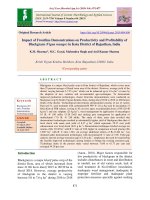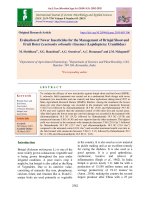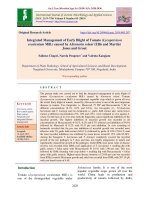Eco-friendly management of anthracnose disease of cowpea (Vigna unguiculata) Sacc. & Magn
Bạn đang xem bản rút gọn của tài liệu. Xem và tải ngay bản đầy đủ của tài liệu tại đây (326.58 KB, 6 trang )
Int.J.Curr.Microbiol.App.Sci (2020) 9(2): 2720-2725
International Journal of Current Microbiology and Applied Sciences
ISSN: 2319-7706 Volume 9 Number 2 (2020)
Journal homepage:
Original Research Article
/>
Eco-friendly Management of Anthracnose Disease of
Cowpea (Vigna unguiculata) Sacc. & Magn
Maria Modi* and Shashi Tiwari
Department of Plant Pathology, Sam Higginbottom University of Agriculture, Technology and
Sciences, Allahabad- 211007 (U.P.), India
*Corresponding author
ABSTRACT
Keywords
Anthracnose,
Colletotrichum
lindemuthianum,
bio-agents,
botanicals.
Article Info
Accepted:
20 January 2020
Available Online:
10 February 2020
An experiment was conducted at experimental field of Plant Pathology,
Sam Higginbottom University of Agricultural, Technology and Sciences,
Allahabad, during the kharif season 2017 to evaluate the effect of
botanicals and bio-agents against Anthracnose of Cowpea caused by
Colletotrichum lindemuthianum. Eight treatments including control
replicated thrice in Randomized block design. In field experiments, the
highest reduction of disease intensity was achieved by Trichoderma viride
(23.703) and Pseudomonas fluorescens (25.550) @ 2% at 30, 60, 90 DAS.
Under invitro condition Eucalyptus oil @ 5% was found most effective
inhibiting mycelial growth (100%) followed by Trichoderma viride
(68.82%). All the treatments significantly reduced the Anthracnose disease
under field conditions.
Introduction
belongs to the family Fabaceae and probably
a native of Central Africa.
The first written reference of the word
'cowpea' appeared in 1798 in the United
States (Small, Ernest 2009). The name was
most likely acquired due to their use as a
fodder crop for cows (Timko et al., 2007).
The cowpea (Vigna unguiculata) is an annual
herbaceous legume from the genus Vigna.
Cultivated cowpeas are known by the
common names black-eyed pea, southern pea,
yardlong bean, catjang, and crowder pea. It
Cowpea is also a kharif legume crop and is
grown across India for seeds, green pods,
animal fodder, and organic green manure. It is
called as vegetable meat due to high nutritious
constitutions with high protein 23-24%,
carbohydrate 60.3%, minerals and vitamins
and also rich source of iron and calcium. The
size and shape of the leaves varies greatly,
making this an important feature for
2720
Int.J.Curr.Microbiol.App.Sci (2020) 9(2): 2720-2725
classifying and distinguishing cowpea
varieties. Flower colour varies through
different shades of purple, pink, yellow and
white and blue (National Research Council
2006).
The term „Anthracnose‟ literally means „like
coal‟ and was first used by Fabre and Dunal
to describe a disease of grapes in which
blackening of tissue was a characteristic
feature. In Nigeria, the disease is one of the
major fungal diseases of cowpea crop. The
fungus overwinters in the previous crop
debris, and can also be seed-borne as dormant
mycelia within the seed coat or as spores
between the cotyledons; from where it
initiates infection of hypocotyls and young
leaves in the field.
The management of plant diseases generally
include strategies such as physical and
cultural control, resistant cultivars, chemical
and biological control. The integration of
different management practices has the
potential to provide an effective strategy for
the control of Anthracnose of Cowpea. Some
bio-control agents have been reported as a
promising disease management tool.
Materials and Methods
The experiments were carried out during
kharif season of 2017-2018 at Department of
Plant
Pathology,
Sam
Higginbottom
University of Agriculture, Technology and
Sciences, Allahabad. The experiment was
conducted in randomized block design with
seven treatments and one control (untreated).
The fields were made weed free, ploughed
and pulverised. Further, the plots were
divided into 24 sub plots. The bunds and
irrigation channels were made. The seed were
sown @ of 20-25 kg/ha by the method of line
sowing with the spacing of 30 cm between
row to row and 15 cm between plant to plant.
Observations recorded were disease severity
and plant height at 30, 60 and 90 DAS. After
harvesting yield were also recorded.
Results and Discussion
Study entitled, “Eco-friendly management of
Anthracnose disease of Cowpea (Vigna
unguiculata) Sacc. & Magn” was conducted
at the Central Research Farm, Department of
Plant
pathology,
Sam
Higginbottom
University of Agriculture, Technology and
Sciences, Allahabad, Uttar Pradesh during the
Rabi season of 2017-18 in randomized block
design having seven treatments and one
control (T0).
The data of 30 DAS shows that the control
(39.92) has the highest disease intensity.
Minimum disease intensity was recorded in
Trichoderma viride @ 2% (12.72), followed
by Pseudomonas fluorecsens @ 2% (15.81),
Eucalyptus oil @ 5% (18.33), Neem oil @
5% (22.336), garlic bulb extract @ 5%
(24.103),Tulsi leaf extract @ 5% (25.866) and
Datura leaf extract @ 5% (29.263).
Trichoderma viride shows the best result
when it was checked 30 DAS. The statistical
analysis of data showed that all treatments
were found significantly effective and
significant over control.
These results were observed invitro
conditions. As we can clearly see from Table
2, that only one botanical exhibits the
inhibition of Colletotrichum lindemuthianum
completely which is Eucalyptus oil with
Radial Growth of 0.00 mm,with 100 percent
inhibition followed by Trichoderma viride
with 68.82 inhibition per cent, Neem oil with
62 inhibition per cent, Datura 61.17 inhibition
percent, Tulsi leaf extract with 59.81 per cent,
Garlic bulb extract with 56.87 per cent and
Pseudomonas
fluorecsens
with
least
inhibition percent i.e. 53.34 %. The statistical
analysis of data showed that all treatments
were found significantly effective and
significant over control.
2721
Int.J.Curr.Microbiol.App.Sci (2020) 9(2): 2720-2725
Table.1 Cowpea at different days of interval
DISEASE INTENSITY
Tr. No.
TREATMENT
NAME
T0
T1
60DAS
90DAS
Control
Datura leaf extract
30
DAS
39.926
29.263
54.730
36.313
67.070
45.810
T2
Tulsi leaf extract
25.866
32.666
43.086
T3
Garlic bulb extract
24.103
28.326
38.576
T4
Neem oil
22.336
27.613
32.753
T5
Eucalyptus oil
18.333
26.936
30.020
T6
Trichoderma viride
12.720
20.706
23.703
T7
Pseudomonas
fluorescens
15.810
25.333
25.550
F Test
S
S
S
S. Ed. (±)
0.34
1.42
2.31
CD (0.05%)
1.49
3.04
3.88
Table.2 Invitro evaluations of botanicals and bio-agents against
Colletotrichum lindemuthianum
Treatment
Radial growth (mm)
T0 Control
85
%Growth
inhibition
0.00
T1 Datura leaf extract
33
61.17
T2 Tulsi leaf extract
34.16
59.81
T3Garlic bulb extract
36.66
56.87
T4Neem oil
32.33
62
T5 Eucalyptus oil
0.00
100
T6Trichoderma viride
26.50
68.82
T7Pseudomonas
fluorescens
F Test
39.66
53.34
S
-
Sem
0.12
-
CD (0.05%)
0.88
-
2722
Int.J.Curr.Microbiol.App.Sci (2020) 9(2): 2720-2725
Fig.1 Symptoms on pods
Fig.2 Symptoms on leaves
Fig.3 Photomicrograph of Colletotrichum lindemuthianum
2723
Int.J.Curr.Microbiol.App.Sci (2020) 9(2): 2720-2725
Fig.4 Poisoned Food technique of Botanical against Colletotrichum lindemuthi
Fig.5 Dual culture technique of Biagents
It is seen from my trials that foliar spray of
Trichoderma viride @ 2% were most
effective in decreasing the disease intensity of
Anthracnose of cowpea followed by
Pseudomonas fluorescens @ 2% .
Hence, this results were similar to the results
of ofHegde et al., (2002). Under lab condition
Eucalyptus oil @ 5% gave the best result in
inhibiting mycelial growth and hence this
results were same as the results of Ramezani
et al., (2002).
From the present studies it can be concluded
that
Eco-friendly
management
of
Anthracnose disease of cowpea can be done
by both botanicals as well as bio-agents as
biological control is an important and integral
part of integrated plant disease management
system, especially against seed borne plant
pathogens.
Bio-agents were more effective than the plant
extracts. Trichoderma viride @ 2% plays a
important role in the growth of plant height as
well as management of this disease both in
the insitu as well as exsitu. But Pseudomonas
fluorescens @ 2% fails in the invitro
condition with least inhibition per cent.
The Eucalyptus oil @ 5% plays a major role
in invitro condition with 100 per cent
inhibition per cent as compared to other. All
other plant extracts @ 5% also played a major
role in management of Anthracnose disease of
cowpea.
2724
Int.J.Curr.Microbiol.App.Sci (2020) 9(2): 2720-2725
References
Hegde, G. M., Anahosur, K. H. and Srikant
Kulkarni,(2002a), Biological control of
Colletotrichum capsici causing fruit rot
of chilli. Pl. Path. Newslet., 20: 4-5.
National Research Council (2006). "Cowpea".
Lost Crops of Africa: Volume II:
Vegetables. Washington DC: The
National Academies Press. pp. 104–
117. doi:10.17226/11763. ISBN 0-30910333-9.
Ramezani H, Singh HP, Batish DRO, Kohli
RK (2002). Antifungal 9. activity of
volatile oil of Eucalyptus citriodora.
Fitoterapia. 2002;73:261-62.
Small, E. (2009).Top 100 food plants.NRC
Research Press.p.104. ISBN 978-0-66019858-3.
Timko, M. P.; Ehlers, J. D.; Roberts, P. A.
(2007). "Cowpea". In Kole, C.Pulses,
Sugar and Tuber Crops,Genome
Mapping and Molecular Breeding in
Plants(PDF). 3. Berlin, Heidelberg:
Springer-Verlag. pp. 49–67.
How to cite this article:
Maria Modi and Shashi Tiwari. 2020. Eco-friendly Management of Anthracnose Disease of
Cowpea (Vigna unguiculata) Sacc. & Magn. Int.J.Curr.Microbiol.App.Sci. 9(02): 2720-2725.
doi: />
2725





![Heterosis studies for seed yield and earliness in intra-specific hybrids of ricebean [Vigna umbellata (Thunb.) ohwi and ohashi] an under utilized pulse](https://media.store123doc.com/images/document/2020_01/09/medium_pxu1578554402.jpg)



